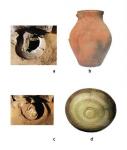Summary (English)
ARCHAEOLOGICAL EXPLORATIONS NEAR THE VILLAGE OF KRUM (Emilia Evtimova – ema_ev@abv.bg, Katya Melamed) Twelve buildings were explored over an area of 0.5 ha. Most of the buildings were sunken-floored and ramshackle and their walls were probably constructed of sun-dried bricks. Rows of postholes, 5 – 8 cm in diameter and 10 – 15 cm in depth, were documented in Buildings Nos. 2 and 5, which were probably constructed of wattle-and-daub. The roofs of the buildings were covered with thatch or reed. All buildings accommodated two – three hearths, except for Building No. 7. Probably the buildings were workshops. Significant quantity of glass slag was found in the buildings: 25.720 kg. Buildings Nos. 3 and 8 had foundations constructed of uneven stones, boulders and fragments of roof tiles and bricks. The finds in Building No. 8 included two coins of Manuel I Komnenos and two fragments from small spoons, but no other liturgical objects were found. The finds in Building No. 3 included a pot, sherds from a dish with sgraffito decoration and significant quantity of melted glass: 7.230 kg. During the excavations, 103 midden and storage pits were explored. The pits were 0.50 – 2.30 m in diameter and 0.40 – 2.20 m in depth, containing charcoal, sherds, coins, metal objects and animal bones. According to the archaeobotanical analysis, walnut-tree, oak, plum-tree, beech-tree, plane-tree, cornel-tree, briar, wheat, barley, millet, lentils and grapes were identified. The settlement dated to the 11th – 12th centuries and was documented over a strip 350 m long and 200 m wide. The finds from the excavations included two bone appliqués from handles of daggers, and coins of John II Komnenos and Manuel I Komnenos.
- Emilia Evtimova - Archaeological Institute with Museum
- Katya Melamed - Archaeological Institute with Museum
Director
Team
Research Body
- Archaeological Institute with Museum






![Download [PDF]](/excavation/skins/fasti/images/results/download_sml.png)

